Changes in the Distribution of Precipitation with the Potential to Cause Extreme Events in the State of Rio de Janeiro for a Future Climate Change Scenario
Abstract
1. Introduction
2. Material and Methods
2.1. Data Used
2.2. Climate Change Detection Indices
3. Results and Discussion
4. Conclusions
Author Contributions
Funding
Institutional Review Board Statement
Informed Consent Statement
Data Availability Statement
Acknowledgments
Conflicts of Interest
References
- Maynard, T.; Beecroft, N.; Gonzalez, S.; Restell, L.; Toumi, R. Catastrophe Modelling and Climate Change; Lloyd’s of London: London, UK, 2014. [Google Scholar]
- Wanderley, H.S.; Bunhak, A.C.d.S. Alteração da precipitação e do número de dias sem chuva na região Sul Fluminense no estado do Rio de Janeiro (Alteration in precipitation and number of days without rain in the southern region of Rio de Janeiro state). Rev. Bras. Geogr. Física 2016, 9, 2341–2353. [Google Scholar] [CrossRef]
- Regueira, A.O.; Wanderley, H.S. Changes in rainfall rates and increased number of extreme rainfall events in Rio de Janeiro city. Nat. Hazards 2022, 114, 3833–3847. [Google Scholar] [CrossRef]
- IPCC–Climate Change 2021: AR6 Synthesis Report. Contribution of Working Groups I, II and III to the Sixth Assessment Report of the Intergovernmental Panel on Climate Change. Issues 1–151. 2021. Available online: https://archive.ipcc.ch/pdf/assessment-report/ar5/syr/SYR_AR5_FINAL_full_wcover.pdf (accessed on 12 October 2024).
- Merz, B.; Blöschl, G.; Vorogushyn, S.; Dottori, F.; Aerts, J.C.; Bates, P.; Bertola, M.; Kemter, M.; Kreibich, H.; Lall, U.; et al. Causes, impacts and patterns of disastrous river floods. Nat. Rev. Earth Environ. 2021, 2, 592–609. [Google Scholar] [CrossRef]
- De Souza Santos, J.A.; Wanderley, H.S.; de Amorim, R.F.C.; Delgado, R.C.; Fernades, R.C. The longest multiannual drought in Northeastern Brazil. J. S. Am. Earth Sci. 2024, 143, 104976. [Google Scholar] [CrossRef]
- Lorentz, J.F.; Calijuri, M.L.; Marques, E.G.; Baptista, A.C. Multicriteria analysis applied to landslide susceptibility mapping. Nat. Hazards 2016, 83, 41–52. [Google Scholar] [CrossRef]
- Myhre, G.; Alterskjær, K.; Stjern, C.W.; Hodnebrog, Ø.; Marelle, L.; Samset, B.H.; Sillmann, J.; Schaller, N.; Fischer, E.; Schulz, M.; et al. Frequency of extreme precipitation increases extensively with event rareness under global warming. Sci. Rep. 2019, 9, 16063. [Google Scholar] [CrossRef]
- Fu, Y.; Mao, Y.; Wu, G. Event-based evaluation of urbanization impact on precipitation during the 1978–2021 warm season over eastern China. Urban Clim. 2024, 56, 102048. [Google Scholar] [CrossRef]
- Zhang, M.; Chen, Y.; Shen, Y.; Li, Y. Changes of precipitation extremes in arid Central Asia. Quaternário Int. 2017, 436, 16–27. [Google Scholar]
- Wanderley, H.S.; Fernandes, R.C.; de Carvalho, A.L. Aumento das temperaturas extremas na cidade do Rio de Janeiro e o desvio ocasionado durante um evento de El Niño intenso (Thermal change in the city of Rio de Janeiro and the deviation caused during an intense El Niño event). Rev. Bras. Geogr. Física 2019, 12, 1291–1301. [Google Scholar] [CrossRef]
- Machado, R.L.; Ceddia, M.B.; de Carvalho, D.F.; da Cruz, E.S.; Francelino, M.R. Spatial variability of maximum annual daily rain under different return periods at the Rio de Janeiro state, Brazil. Bragantia 2010, 69, 77–84. [Google Scholar]
- Pristo, M.V.D.J.; Dereczynski, C.P.; Souza, P.R.D.; Menezes, W.F. Climatologia de chuvas intensas no município do Rio de Janeiro. Rev. Bras. Meteorol. 2018, 33, 615–630. [Google Scholar] [CrossRef]
- Carvalho, L.V.; Wanderley, H.S. Risk identification of precipitation extremes due to climate change in the southern region of the state of Rio de Janeiro. Rev. Bras. Geogr. Física 2022, 15, 2073–2085. [Google Scholar] [CrossRef]
- Da Silva, F.P.; da Silva, A.S.; da Silva, M.G.A.J. Extreme rainfall events in the Rio de Janeiro city (Brazil): Description and a numerical sensitivity case study. Meteorol. Atmos. Phys. 2022, 134, 77. [Google Scholar] [CrossRef]
- Dourado, F.; Arraes, T.C.; Silva, M.F. O Megadesastre da Região Serrana do Rio de Janeiro--as Causas do Evento, os Mecanismos dos Movimentos de Massa e a Distribuição Espacial dos Investimentos de Reconstrução no Pós-Desastre. In Anuário do Instituto de Geociências; Universidade Federal do Rio de Janeiro: Rio de Janeiro, Brazil, 2012. [Google Scholar]
- Ehrlich, M.; Luiz, B.J.; Mendes, C.G.; Lacerda, W.A. Triggering factors and critical thresholds for landslides in Rio de Janeiro-RJ, Brazil. Nat. Hazards 2021, 107, 937–952. [Google Scholar] [CrossRef]
- Pereira, R.M.S.; Wanderley, H.S.; Delgado, R.C. Homogeneous regions for rainfall distribution in the city of Rio de Janeiro associated with the risk of natural disasters. Nat. Hazards 2022, 111, 333–351. [Google Scholar] [CrossRef]
- METSUL. #CriseClimáticaNoRJ: Regiões Norte e Noroeste do Estado do Rio Sofrem Com Secas e Fortes Chuvas—Diário do Rio de Janeiro (diariodorio.com). Available online: https://metsul.com/2024-01-14-chuva-rio-de-janeiro-deslizamentos/ (accessed on 3 August 2024).
- Debortoli, N.S.; Camarinha, P.I.M.; Marengo, J.A.; Rodrigues, R.R. An index of Brazil’s vulnerability to expected increases in natural flash flooding and landslide disasters in the context of climate change. Nat. Hazards 2017, 86, 557–582. [Google Scholar]
- Swart, N.C.; Cole, J.N.; Kharin, V.V.; Lazare, M.; Scinocca, J.F.; Gillett, N.P.; Anstey, J.; Arora, V.; Christian, J.R.; Hanna, S.; et al. The Canadian earth system model version 5 (CanESM5. 0.3). Geosci. Model Dev. 2019, 12, 4823–4873. [Google Scholar] [CrossRef]
- Tatebe, H.; Ogura, T.; Nitta, T.; Komuro, Y.; Ogochi, K.; Takemura, T.; Sudo, K.; Sekiguchi, M.; Abe, M.; Saito, F.; et al. Description and basic evaluation of simulated mean state, internal variability, and climate sensitivity in MIROC6. Geosci. Model Dev. 2019, 12, 2727–2765. [Google Scholar] [CrossRef]
- Mauritsen, T.; Bader, J.; Becker, T.; Behrens, J.; Bittner, M.; Brokopf, R.; Brovkin, V.; Claussen, M.; Crueger, T.; Esch, M.; et al. Developments in the MPI-M Earth System Model version 1.2 (MPI-ESM1.2) and its response to increasing CO2. J. Adv. Model. Earth Syst. 2019, 11, 998–1038. [Google Scholar] [CrossRef]
- Zhang, X.; Yang, F. RClimDex (1.0)—User Manual; Climate Research Branch Environment Canada Downsview: Toronto, ON, Canada, 2004. [Google Scholar]
- Luiz-Silva, W.; Oscar-Júnior, A.C. Climate extremes related with rainfall in the State of Rio de Janeiro, Brazil: A review of climatological characteristics and recorded trends. Nat. Hazards 2022, 114, 713–732. [Google Scholar] [CrossRef]
- Lucena, F. #CriseClimáticaNoRJ: Regiões Norte e Noroeste do estado do Rio sofrem com secas e fortes chuvas. Diário do Rio de Janeiro, 9 August 2024. [Google Scholar]
- De Moraes, J.B.; Wanderley, H.S.; Delgado, R.C. Areas susceptible to desertification in Brazil and projected climate change scenarios. Nat. Hazards 2023, 116, 1463–1483. [Google Scholar] [CrossRef]
- Silva, W.L.; Dereczynski, C.P. Caracterização climatológica e tendências observadas em extremos climáticos no estado do Rio de janeiro. Anuário Inst. Geociências 2014, 37, 123–138. [Google Scholar] [CrossRef]
- Zscheischler, J.; Martius, O.; Westra, S.; Bevacqua, E.; Raymond, C.; Horton, R.M.; van den Hurk, B.; AghaKouchak, A.; Jézéquel, A.; Mahecha, M.D.; et al. A typology of compound weather and climate events. Nat. Rev. Earth Environ. 2020, 1, 333–347. [Google Scholar] [CrossRef]
- O’Gorman, P.A.; Schneider, T. The physical basis for increases in precipitation extremes in simulations of 21st-century climate change. Proc. Natl. Acad. Sci. USA 2009, 106, 14773–14777. [Google Scholar] [CrossRef]
- Pfahl, S.; O’gorman, P.A.; Fischer, E.M.; O’Gorman, P.A.; Fischer, E.M. Understanding the regional pattern of projected future changes in extreme precipitation. Nat. Clim. Change 2017, 7, 423–427. [Google Scholar] [CrossRef]
- Chernokulsky, A.; Kozlov, F.; Zolina, O.; Bulygina, O.; Mokhov, I.I.; Semenov, V.A. Observed changes in convective and stratiform precipitation in Northern Eurasia over the last five decades. Environ. Res. Lett. 2019, 14, 045001. [Google Scholar] [CrossRef]
- Alves, G.J.; Mello, C.R.; Guo, L.; Thebaldi, M.S. Natural disaster in the mountainous region of Rio de Janeiro state, Brazil: Assessment of the daily rainfall erosivity as an early warning index. Int. Soil Water Conserv. Res. 2022, 10, 547–556. [Google Scholar] [CrossRef]
- Alves, G.J.; Mello, C.R.; Guo, L. Rainfall disasters under the changing climate: A case study for the Rio de Janeiro mountainous region. Nat. Hazards 2023, 116, 1539–1556. [Google Scholar] [CrossRef]
- Alcântara, E.; Marengo, J.A.; Mantovani, J.; Londe, L.; San, R.L.Y.; Park, E.; Lin, Y.N.; Mendes, T.; Cunha, A.P.; Pampuch, L.; et al. Deadly disasters in Southeastern South America: Flash floods and landslides of February 2022 in Petrópolis, Rio de Janeiro. Nat. Hazards Earth Syst. Sci. 2023, 23, 1157–1175. [Google Scholar] [CrossRef]
- Fardin, S.C.S.G.; Aguilar-Muñoz, V.; Dias, L.F.; Tanus, B.J.M.; do Amaral Cunha, A.P.M. Identificação de eventos extremos de precipitação e desastres deflagrados por chuvas no município de Petrópolis-RJ. Sustain. Debate 2023, 14, 84–113. [Google Scholar] [CrossRef]
- Holender, B.V.; Santos, E.B. Análise de tendência dos eventos de precipitação intensa no sudeste do Brasil. Rev. Bras. Climatol. 2023, 32, 584–606. [Google Scholar] [CrossRef]
- Néto, N.C.G.; Santos, E.B. Análise espaço-temporal dos eventos de precipitação intensa no Estado do Rio de Janeiro. Rev. Bras. Meteorol. 2022, 37, 89–97. [Google Scholar] [CrossRef]
- Lima, S.S.; Armond, N.B. Rainfall in Metropolitan Region of Rio de Janeiro: Characterization, extreme events, and trends. Soc. Nat. 2022, 34, e64770. [Google Scholar] [CrossRef]
- Coelho, L.A.F.; Nunes, A.B. Eventos Recentes de Chuva Intensa na Cidade do Rio de Janeiro: Análise Sinótica. Rev. Bras. Geogr. Física 2020, 13, 994–1012. [Google Scholar]
- Allen, M.R.; Ingram, W.J. Constraints on future changes in climate and the hydrologic cycle. Nature 2002, 419, 224–232. [Google Scholar] [CrossRef]
- Pereira, V.C.M.; Bertolino, A.V.F.A.; Kede, M.L.F.M.; Delazeri, E.M. As chuvas de verão sob a influência do fenômeno El Niño, entre 2005 e 2018, e o risco de inundações no município de São Gonçalo-RJ (Brasil). Territorium 2021, 28, 27–41. [Google Scholar] [CrossRef]


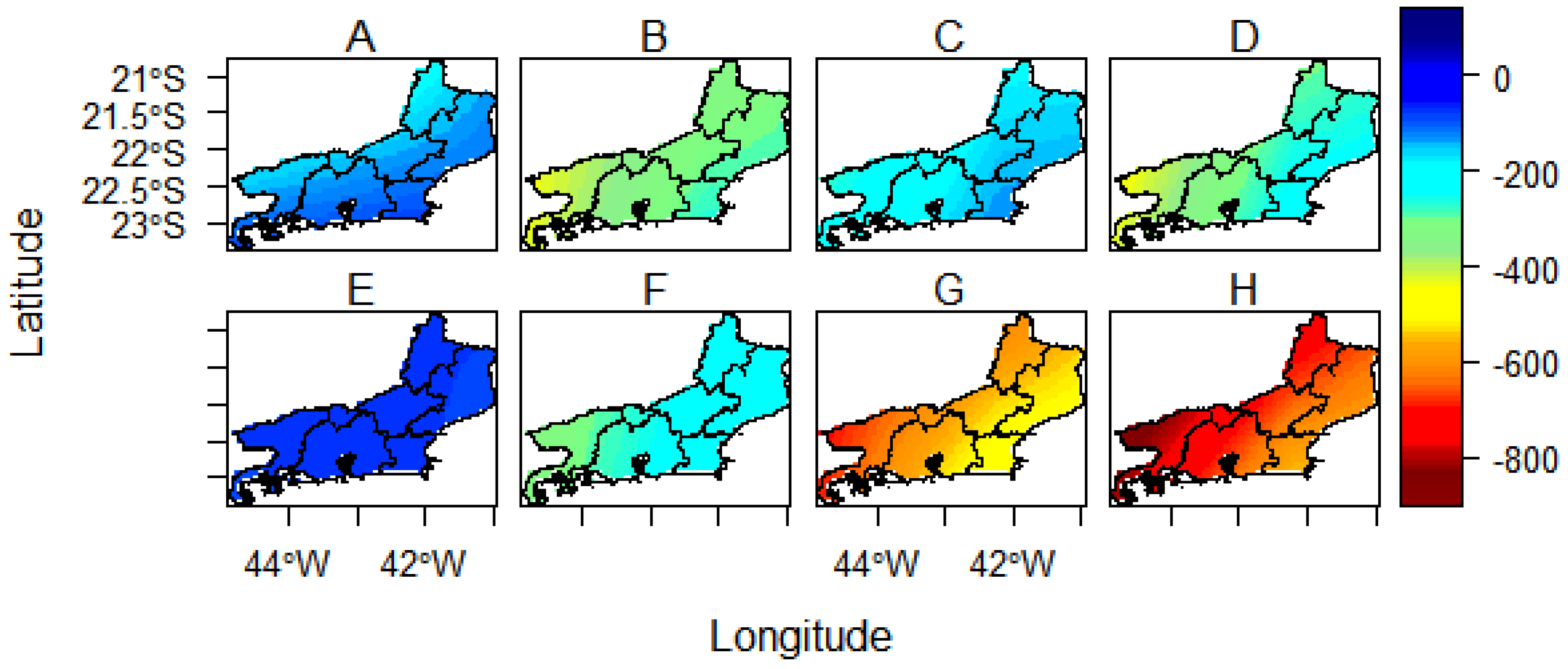
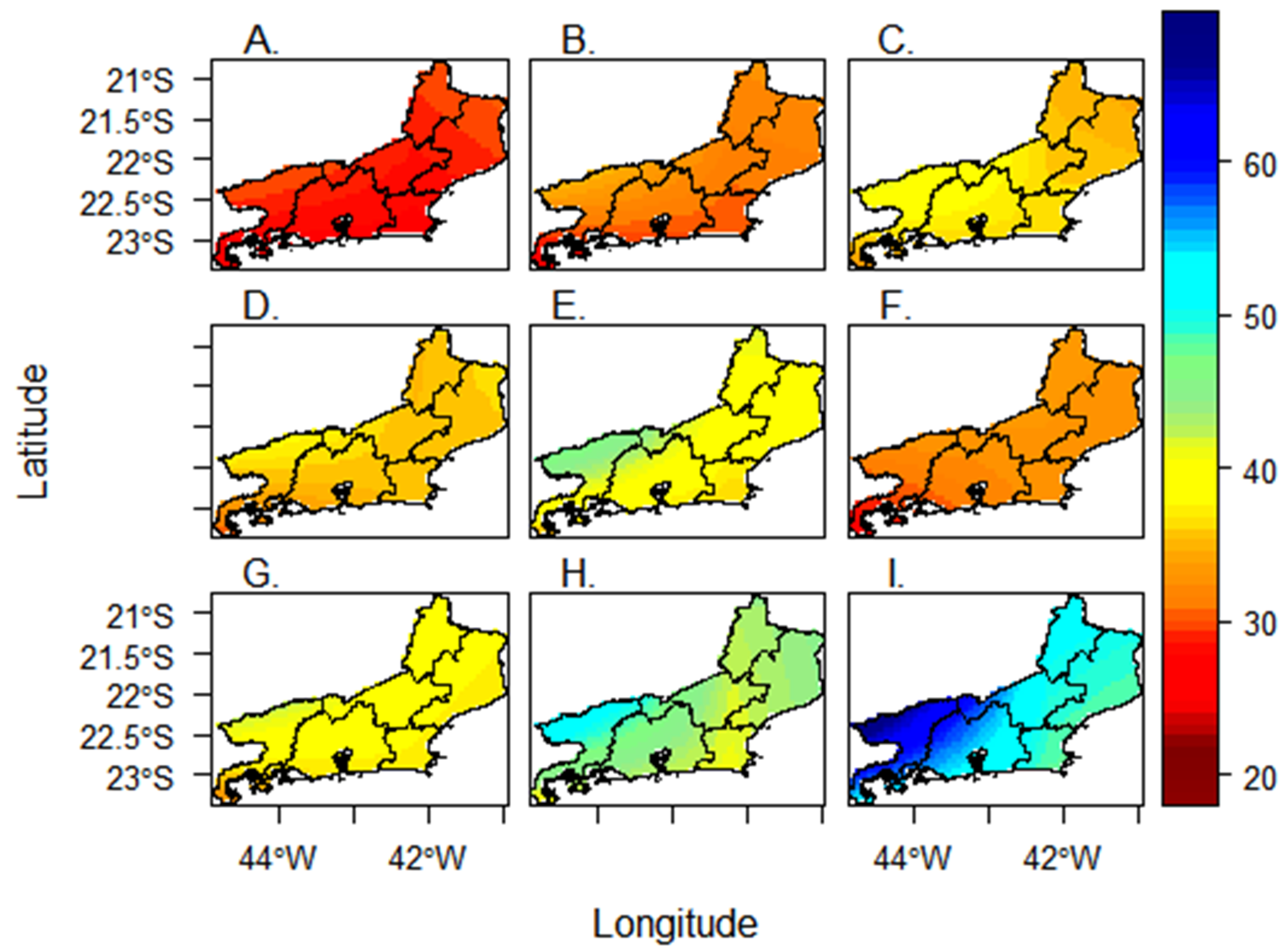
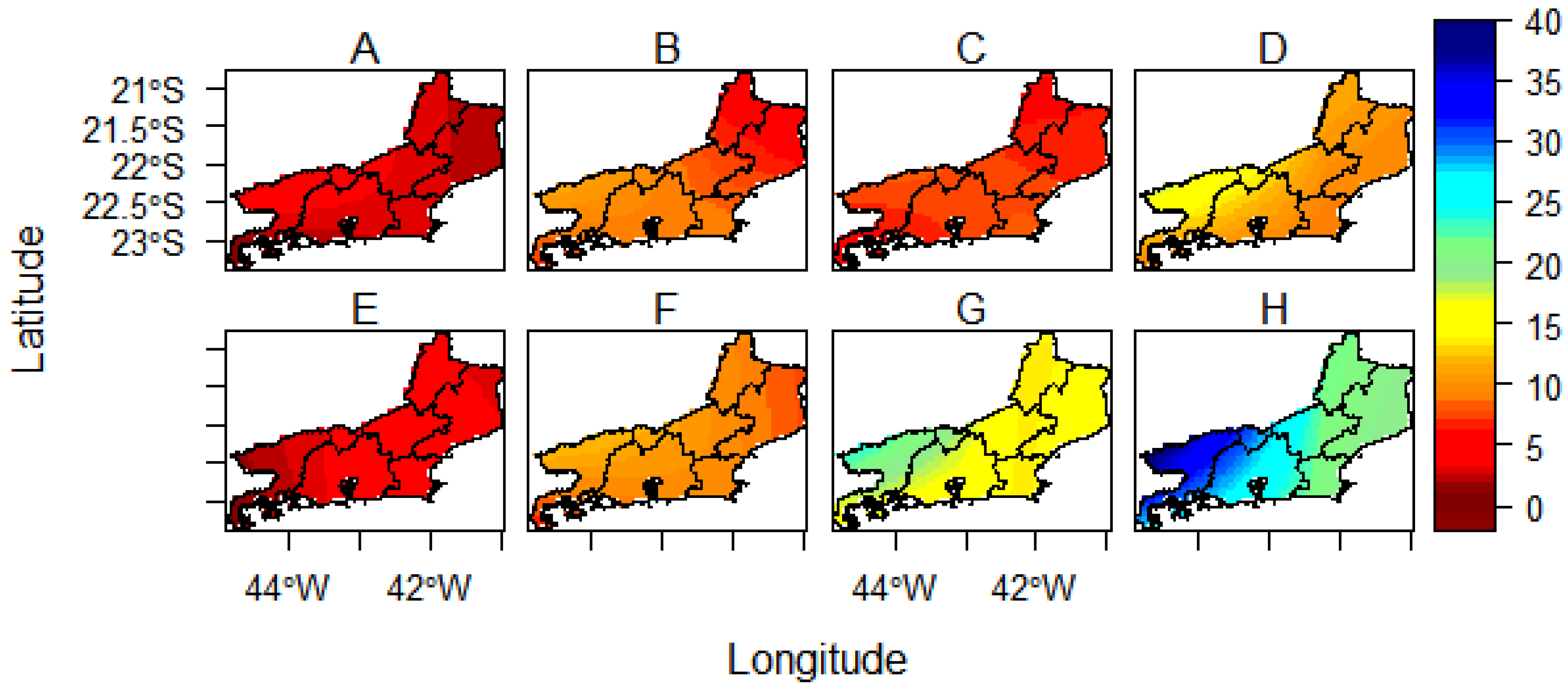

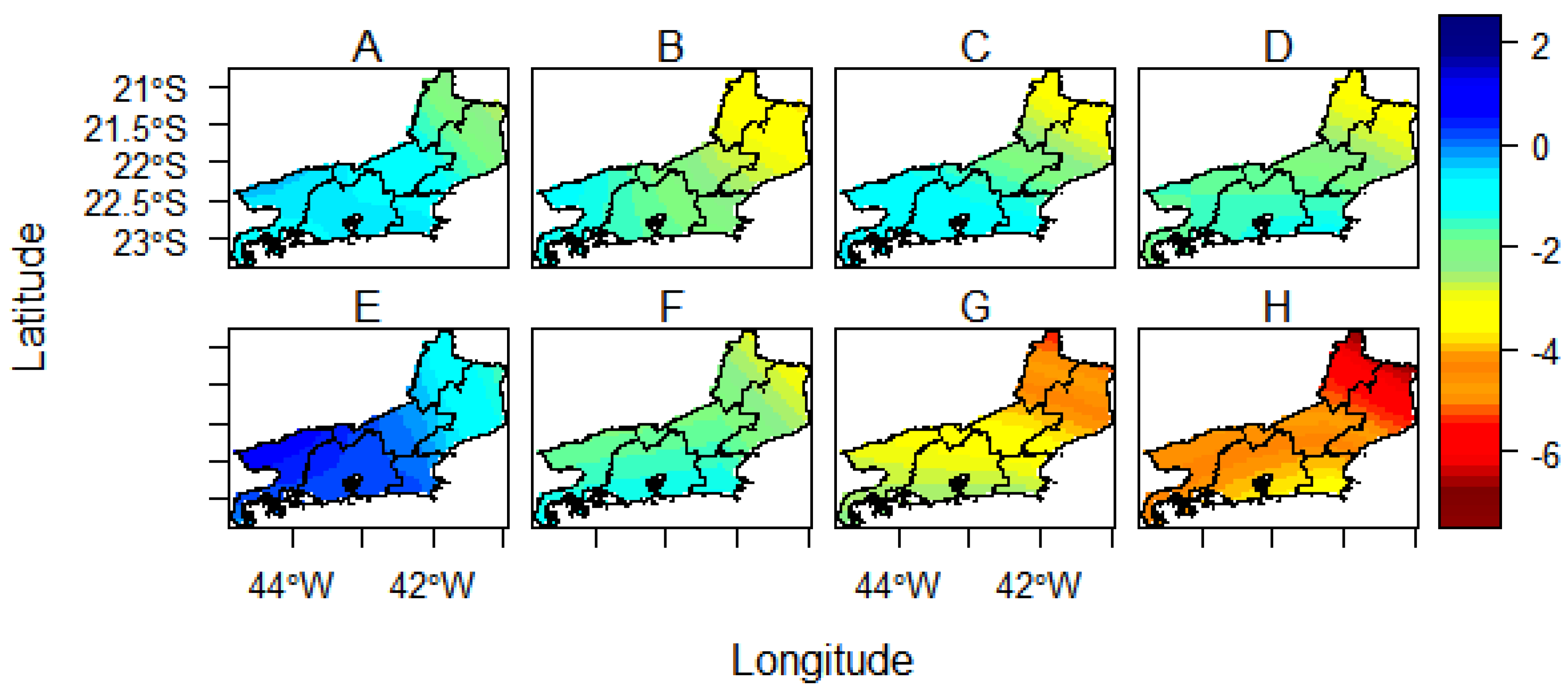
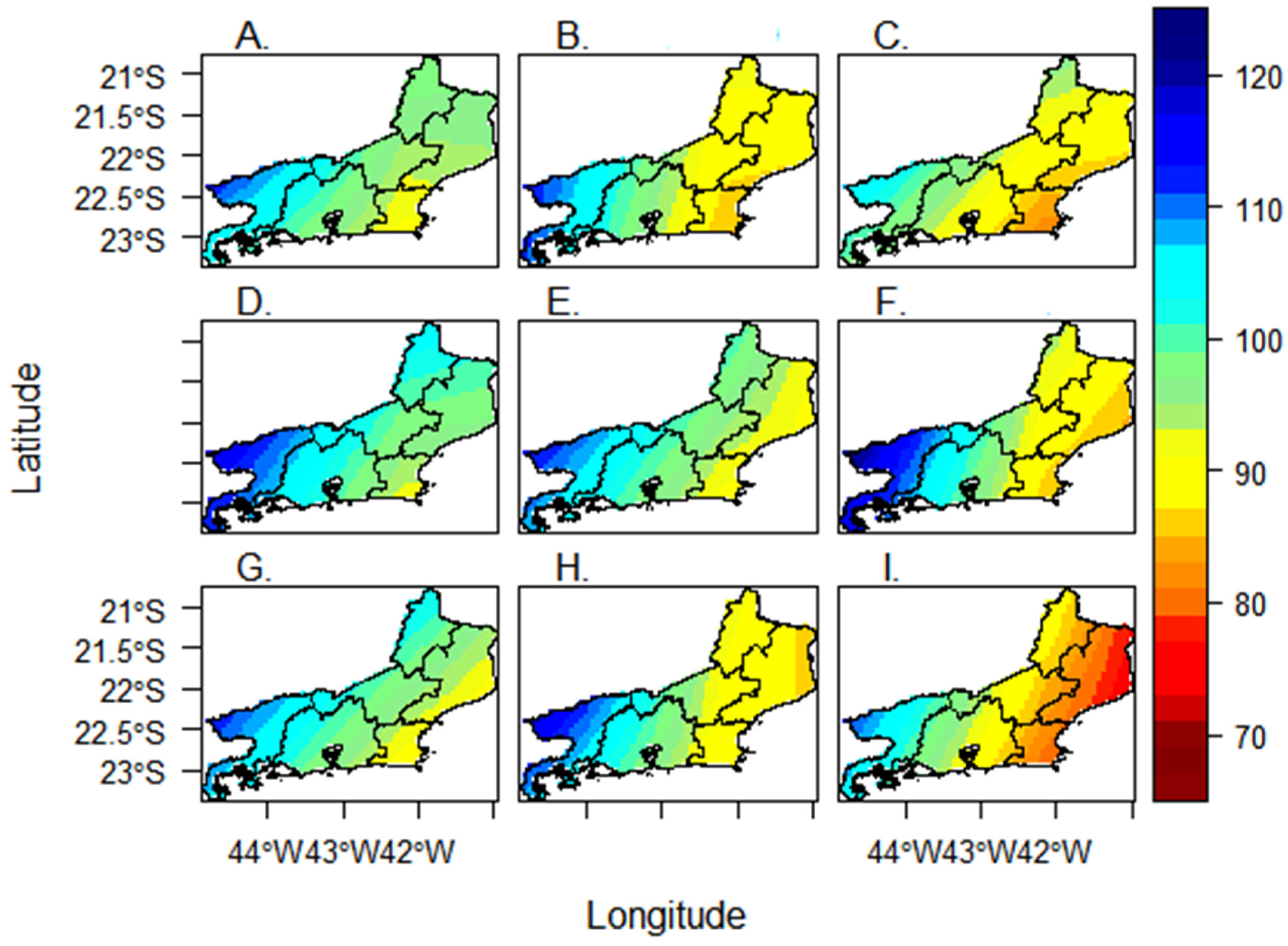
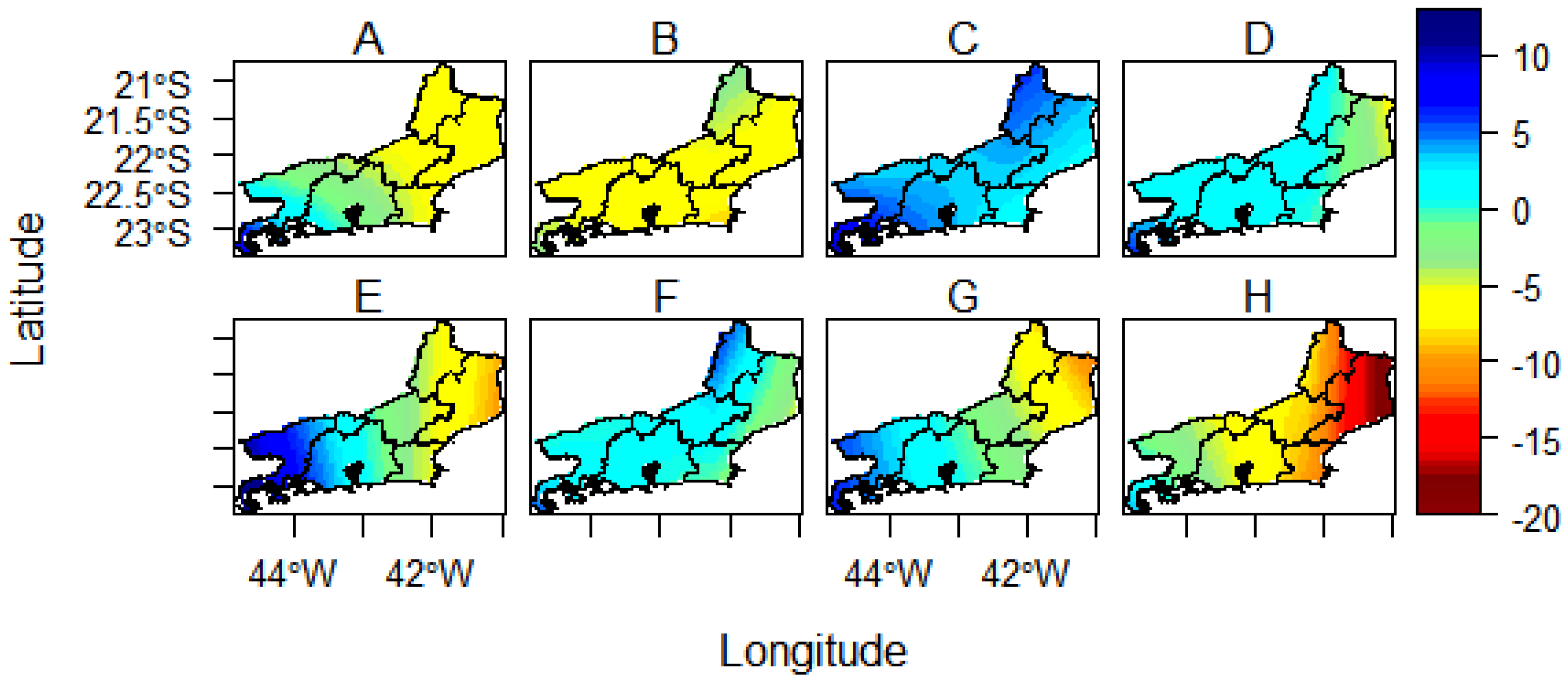

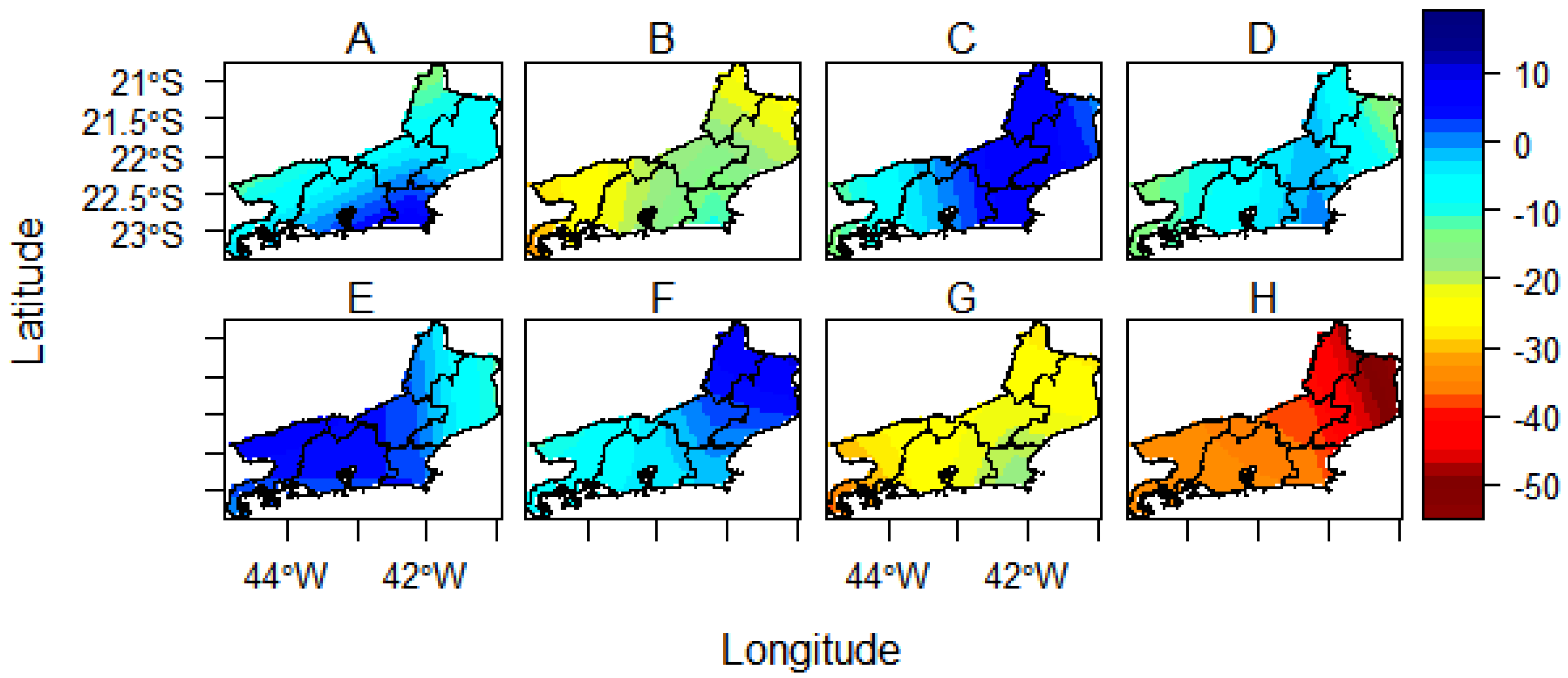
| Index | Index | Definitions | Units |
|---|---|---|---|
| PRCPTOT | Annual total precipitation on wet days | Let RRij be the daily wet day (≥1 mm) precipitation amount on day i in period j. | mm |
| CDD | Maximum number of consecutive days with RR < 1 mm | Let RRij be the daily precipitation amount on day i in period j. Count the largest number of consecutive days where RRij < 1 mm. | days |
| CWD | Maximum number of consecutive days with RR ≥ 1 mm | Let RRij be the daily precipitation amount on day i in period j. Count the largest number of consecutive days where RRij ≥ 1 mm. | days |
| Rx1day | Maximum 1-day precipitation amount | Let RRij be the daily precipitation amount on day I in period j. The maximum 1-day value for period j is Rx1dayj = max (RRij) | mm |
| Rx5day | Maximum consecutive 5-day precipitation | Let RRkj be the precipitation amount for the 5-day interval ending k, period j. Then, maximum 5-day values for period j are Rx5dayj = max (RRkj) | mm |
Disclaimer/Publisher’s Note: The statements, opinions and data contained in all publications are solely those of the individual author(s) and contributor(s) and not of MDPI and/or the editor(s). MDPI and/or the editor(s) disclaim responsibility for any injury to people or property resulting from any ideas, methods, instructions or products referred to in the content. |
© 2025 by the authors. Licensee MDPI, Basel, Switzerland. This article is an open access article distributed under the terms and conditions of the Creative Commons Attribution (CC BY) license (https://creativecommons.org/licenses/by/4.0/).
Share and Cite
Ferreira, W.P.C.; Wanderley, H.S.; Delgado, R.C. Changes in the Distribution of Precipitation with the Potential to Cause Extreme Events in the State of Rio de Janeiro for a Future Climate Change Scenario. Atmosphere 2025, 16, 358. https://doi.org/10.3390/atmos16040358
Ferreira WPC, Wanderley HS, Delgado RC. Changes in the Distribution of Precipitation with the Potential to Cause Extreme Events in the State of Rio de Janeiro for a Future Climate Change Scenario. Atmosphere. 2025; 16(4):358. https://doi.org/10.3390/atmos16040358
Chicago/Turabian StyleFerreira, Wanderley Philippe Cardoso, Henderson Silva Wanderley, and Rafael Coll Delgado. 2025. "Changes in the Distribution of Precipitation with the Potential to Cause Extreme Events in the State of Rio de Janeiro for a Future Climate Change Scenario" Atmosphere 16, no. 4: 358. https://doi.org/10.3390/atmos16040358
APA StyleFerreira, W. P. C., Wanderley, H. S., & Delgado, R. C. (2025). Changes in the Distribution of Precipitation with the Potential to Cause Extreme Events in the State of Rio de Janeiro for a Future Climate Change Scenario. Atmosphere, 16(4), 358. https://doi.org/10.3390/atmos16040358






